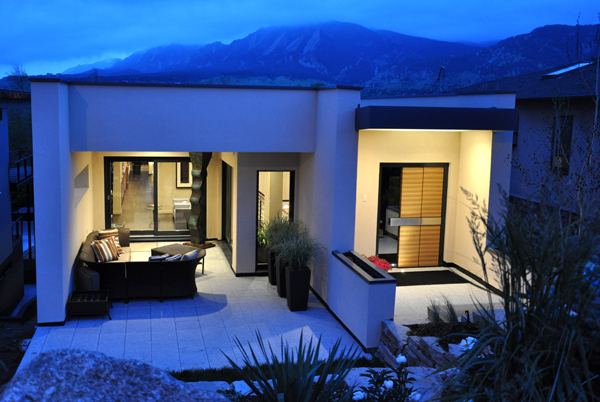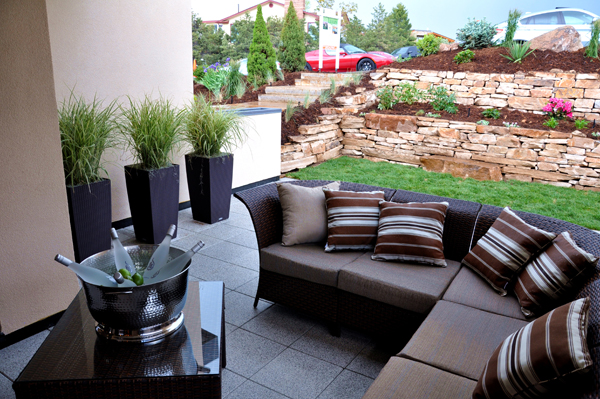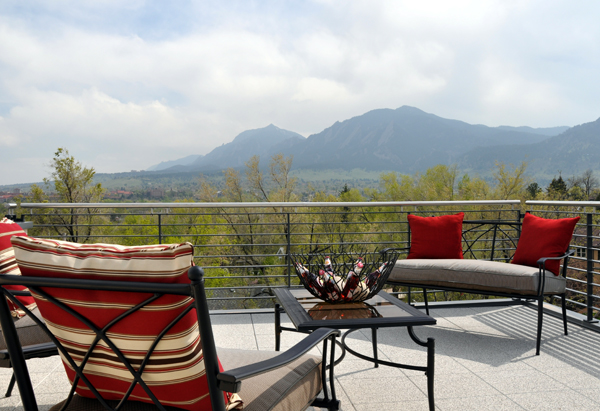Have you ever wondered what kind of home $3.5 million might buy you? If you live, or want to live, in Boulder, Colorado, that home might be 2002 Alpine – said to be the United States’ first ever American-designed, German engineered hyper ecoluxury urban home. It truly looks like a modern architectural marvel, completed in less than a year and standing at 5,160 square feet (with garage). It sports a variety of eco-features, including solar photo-voltaic panels, bespoke timber from consciously-managed forests, an interior that is said to be entirely hypoallergenic and non-toxic and a projected energy usage that “is 18% the average energy use of a typical U.S. home.”
2002 Alpine was designed by Boulder-based architect Studio H:T, engineered in Germany’s WeberHaus factory and assembled on-site by Vireo, a builder of self-described eco-luxury homes. The term eco-luxury, in fact, is used quite extensively in describing this property. To find out more about this term and what went into building Alpine 2002, we turned to one of the project’s collaborators – David Peri of Periscope Marketing – for details:

EarthTechling (ET): What is the background on Alpine 2002?
David Peri: This could fill an encyclopedia, as we could answer it starting in 1898 when this style of house was first started to be developed in Germany, or look at after WW2 when Germany put a concerted effort into developing technologies for the home that minimized energy & material use, or track the five generations of evolution that WeberHaus has engaged in and delivered over the last five decades to continually refine and deliver both higher ecological performance, luxury and longevity in the highest quality homes possible to live in.
Or we could just talk about the last 12 years when Ralf Meier worked to bring these high ecological/luxury homes to the US, how I have been working with him for four years to make this possible during the largest downturn of the economy, banking and home building industry since WW2, or focus on how all these efforts finally culminated in building what we believe is the first uncompromised system engineered and built EcoLuxury home in the US from Germany.
With all those as possible answers to your question, I will instead focus on the idea behind this home – because the idea is more radical than any of the technology – that combining uncompromised ecological performance with luxury is an oxymoron and can’t be done. This is about finding a better way to live, not just building a better home – although the former produces the latter.
Homes are and have almost always been a commodity in the US. A commodity defined as the lowest possible price on interchangeable objects whose only differences are location, date of purchase. Yes the finish details can vary, and some details are nicer than others, but on-site stick construction makes these differences superficial. From a performance and longevity perspective, they are all the same. Built on-site with indifferent labor with materials good enough to do the job, designed to last about 30 years but requiring constant work to keep functioning as the treadmill of obsolescence and low cost keep an army in motion taking stuff to the landfill while workman slave to keep the house going. But when your average American only lives in a house for a little more than four years, there is little incentive to change this endless cycle.

This is an attempt to break that wasteful cycle – and is the real revolution hidden behind the walls and technology of 2002 Alpine; instead of building what is ostensibly throw-away homes designed to minimal standards – turn that pyramid on its head and build the best possible home designed to last for the unheard of time (in America at least) of 250 years, with a minimum of 100 years of daily use without having to replace any major systems or parts of the house.
Once you understand this house is meant to last for centuries and not a couple of decades, the rest falls into place and becomes clear how and why it performs so much better. The home is more like a spaceship than a house. Why? Because, like a spaceship, every piece is designed from the beginning to support the mission, not added in ad hoc without being part of a master plan. And the mission is to create an attractive home that sacrifices nothing – uses the least amount of total energy over a century, uses the best materials so nothing has to be replaced in a century or more of daily use, to create an seductive environment that all your senses rejoice at being able to experience, while minimizing the total environmental impact – not just in arbitrary little time slices – but over a total canvas lasting centuries.

This isn’t about making it cheaper, or faster, or quicker, but about how to make it better. This isn’t about moving individual pieces of the house in a “greener” direction, but about working to make that quantum leap of getting to the destination of having the greenest lifestyle and home without going through all the tiny intervening steps to get there by trying to do it with on-site stick built homes. Change the baseline of use to a century or two or three, and suddenly if you solve for that kind of lifetime total energy and ecological issues, you then also profoundly impact the day to day energy and ecological impact as well.
We have tried to make the collection of thinking – and answers – evident in 2002 Alpine. This isn’t about perfection, but living that good life, and not looking at the pieces but looking at the total impact, and using a total systems engineered home to get there. If all of the U.S. home building asked that question first, their answer would be closer to ours, instead of fungible commodities.
ET: It is stated on the Alpine 2002 Web site that this custom home is “pioneering the future of home building in America.” How so?
Peri: The word pioneer etymologically comes from French “pionier”, and from Medieval Latin before that, “pedon-, pedo” — meaning foot soldier; further, Merriam-Webster says it most defines a member of a unit usually of construction engineers, or secondarily, a person or group that originates or helps open up a new line of thought or activity or a new method or technical development, or one of the first to settle in a territory.
To that end we are doing just that. Benjamin Franklin wrote “Waste Not, and Want Not” in Poor Richard’s Almanac as a way to live in the late 18th Century. Now is the time to live by those words. We have finally reached a stage in civilization where we can no longer sustain hyper consuming: it is destroying the world, using up its resources and bankrupting us in the process. Instead of focusing on making inherently wastefully designed homes that are designed to be replaced every few decades, that are filled with cheap materials that must constantly be replaced before everything is scraped away to start the cycle again, true conservation starts by designing something that is both functional indefinitely – and attractive and pleasing enough to want to use it indefinitely.

To be embraced, real environmentalism shouldn’t be the functional equivalent of wearing a hair shirt – which religious zealots have done for centuries – because by doing something uncomfortable and difficult you can call attention to your will to force yourself down a path, even when you don’t want to travel that path.
ET: What makes the Alpine 2002 home “unapologetically green”?
Peri: The apologies for being green usually revolve around what you can’t do, instead of what you can do. No such apologies are needed here. This home is the equal of any luxury home in how well the occupants are lovingly cared for. A delight to all the physical senses: beautiful to look at, wonderful to touch and use, rewarding to spend time inside the walls from the sweet smell of the American Clay walls which cleans the air with its natural properties, to the constant warmth of the home regardless of the weather outside – 1) because the north wall is 28 feet into the thermal constancy of mother earth; 2) the photovoltaic roof is always producing 9.28KW of electricity, either for the home to use or to feed back into the local electrical grid; 3) that the solar thermal panels are producing water heated to hundreds of degrees F both to store as energy into the mass of the radiant heat floors as well in the dual coil water heater for use of the occupants; 4 for the 98%-99% efficient natural gas Vitodens 200 heater where its many world patents provide a hyper efficient way of extracting energy from natural gas with minimal greenhouse gases for those rare times when more heat is needed. In this total systems engineered home all of this takes place without fuss, without worry, without constant repairs and monitoring. For a century or two or three.

The woods are from sustainably managed and harvested German, American & African forests. The multi-axis windows open in many directions, have dual coated double panes which reflect 92% of the energy on both sides of the glass, and have forged nautical grade stainless steel to last reliably for centuries, using aerospace grade ball bearings and tolerances so the internal pieces of the windows and mechanisms can reliably stand up to a century or more of daily use.
And while many luxury homes create embarrassment for the owners, or dissent within the family that resources or money is wasted for pleasure today and the expense of what the family, community or world will later need – no apology is needed here: this luxury is taking pride at your investment because it isn’t for vanity but to give back – to yourself, your family, your community, your world.

ET: How does it compare to other custom green homes, such as the Zero Energy Casita?
Peri: The Zero Energy Casita is similar in its understanding of needing to minimize energy consumption, choosing specific materials for their contribution to a total solution, but very different in execution. ZEC still uses the on-site building techniques even though SIPs panels are used in the walls. There is rightly a concern for cost, which in trying to keep it as low as possible – which is the predominant commodity mindset behind the fungible similarity in interchangeable homes that only vary by location and size, 2002 Alpine takes another task – how great can you make the performance regardless of price?

The 250 year design lifetime of our house then dictates the use of the highest quality materials, from aerospace hardware to woods harvested, not only in an ecologically sustainable way, but for strength, beauty and longevity as the best possible wood for its specific use.
This last technique is less for the masses, but in being a pioneering method that, if embraced, allows these technologies to immediately start percolating down into the lower price points where it can impact more of the total problem with homes that are anything but ecological. Like racing cars that pioneer engineering breakthroughs that first find their way into more expensive cars, but soon those features are found on every car. Our hope is this evolution will take place here once the total systems engineering solutions are embraced.
ET: We’ve noticed the term “EcoLuxury” used in association with this home. What exactly does that mean?
Peri: EcoLuxury isn’t just a phrase, or a marketing term – but the distilled essence of the two areas this home is designed to offer unequalled total performance in. Ecology & Luxury – terms that most feel are contradictory. But what is more luxurious than not wasting your own resources on a home designed to be thrown away? More luxurious than having the finest natural woods, materials surround you with functionality that delights your senses while it works for decades without constant replacement and repair?
In America, 41% of our total energy use goes into building, heating, cooling, repairing, selling and then tearing down our homes. Is it a luxury, or an answer to our nation’s strategic needs to have homes that use 18% of that average – a 82% reduction in energy use in operation – as 2002 Alpine will do. Then multiply that over a century, and the savings, the luxury of having that choice – becomes ever more compelling.
